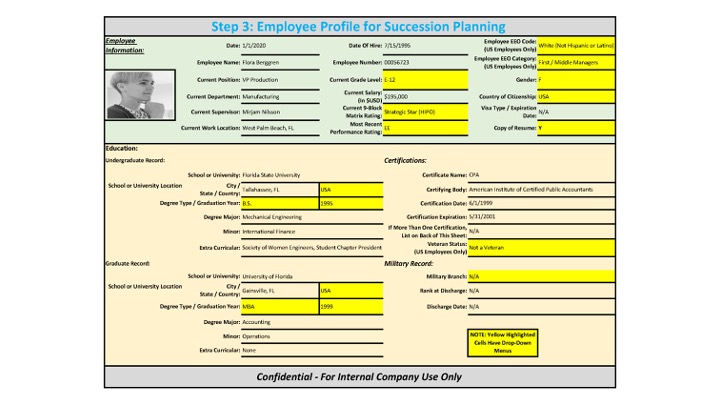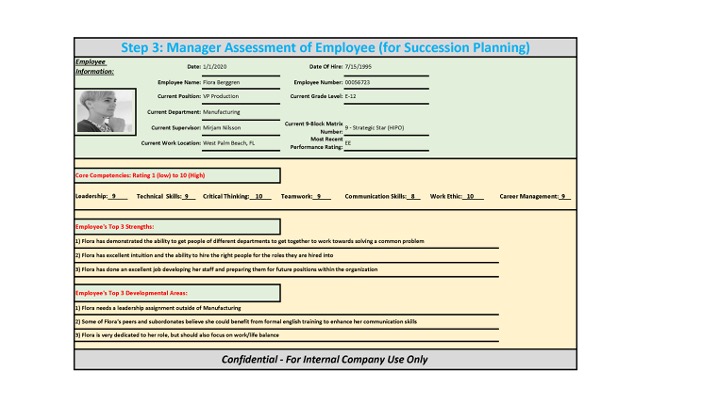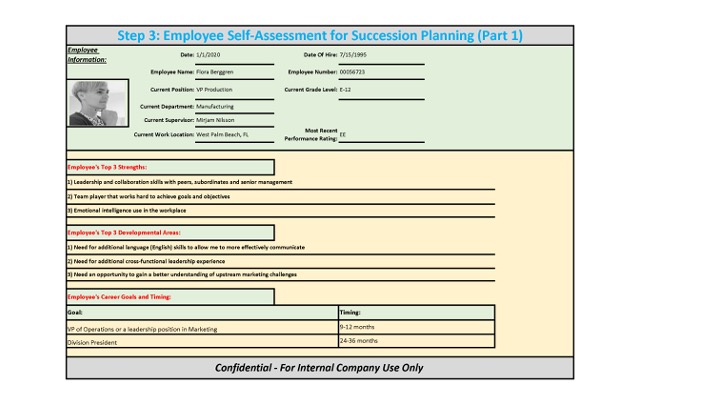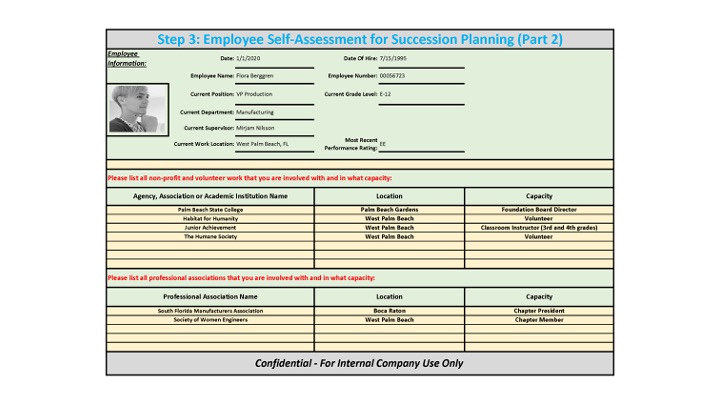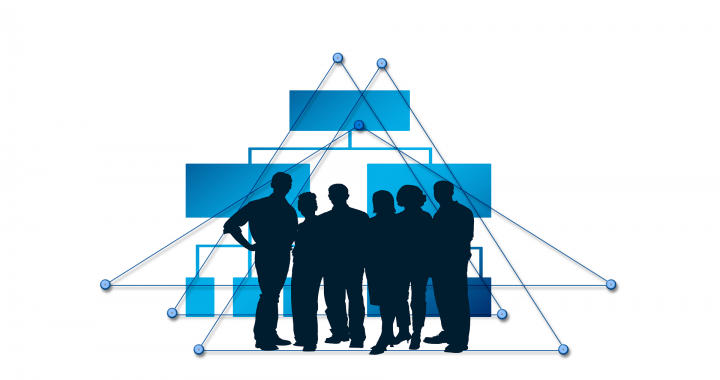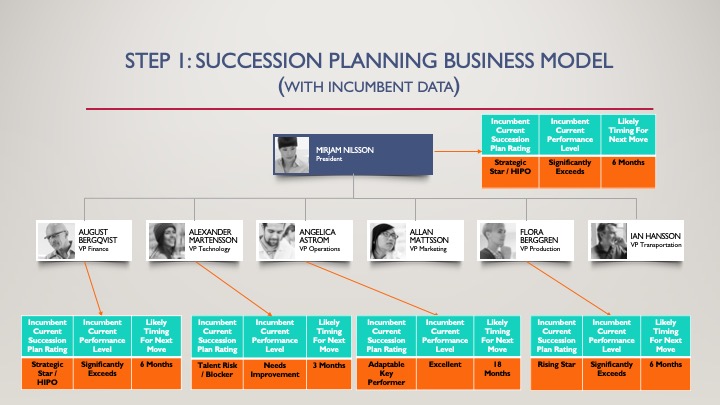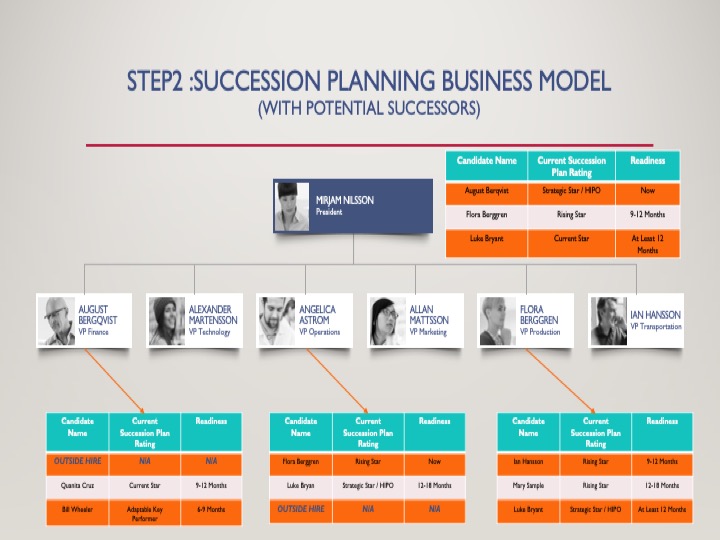When considering a succession plan for your business, there are a number of steps you can take to ensure you have a solid, well thought out plan. In Part 1 and 2 of this series, we discussed the importance of Succession Planning and the 9-Block People Matrix and the Succession Planning Business Model. Today, we will tackle the last component of the Succession Planning Process: the Individual Employee Profile.
Individual employee profiles
A world-class succession planning process involves gathering employee data and information from 3 sources:
1) the company / Human Resources,
2) the incumbent employee’s supervisor assessment of the employee, and,
3) the incumbent employee’s self-assessment.
Typical information referred to and used in succession planning discussions include:
- Employee Employment Data An employee picture (if available), name, title, date of hire, grade level, performance rating, 9-Block People Matrix data, etc. A current employee resume, if on file.
- EEOC Data Employees’ EEO code, EEO Category, gender, military service, relevant disability acknowledgments, accommodations or restrictions, the company’s Affirmative Action Plan. Including EEOC information is a best practice to assure compliance with any Affirmative Action Plans or requirements even if your company does not provide products or services to the US government. Age should not be a factor in discussions unless an incumbent employee has notified the company of an impending retirement. All of this information is highly confidential, shouldn’t be distributed and is best managed by Human Resources professionals.
- Educational Information Every degree (both graduate and undergraduate degrees) as well as degree type, major and any minors achieved. Year of graduation is not important unless the coursework shows a significant change and is relevant for the role being considered. For example, if an employee has an undergraduate degree in engineering and a graduate degree in human resources, that employee could / should be considered for positions in both the engineering and human resources functional areas of the business.
- Professional Certifications All certifications that an employee has achieved should be captured. These could be technical certifications, like Microsoft Office Certification or a professional certification like a CPA.
- Technical Training Technical / job related training or experience from either current or previous employers, should be included where available, especially if it relates to a position that the employee is being considered for outside his/her area of functional responsibility.
- Leadership Training Any formal training received, from either internal or external sources in support of traditional leadership development skills.
- Professional Experience Experience from both the employee’s current and previous jobs. Information should include company, position, location and any performance awards or highlights when available.
- Company Positions and Salary History All positions and salary changes for the employee.
Once the profile has been completed, the employee should update or validate it for future organizational use. Figure 1 is an example of an employee data profile prepared by the company and used for the succession planning process.
Figure 1. Sample employee profile for succession planning discussions
Manager’s assessment
The second source of data used in succession planning discussions is the employee’s manager’s assessment.
The assessment should be both quantitative and qualitative if possible. In Figure 2, the Core Competencies of the company are rated on a scale of 1 to 10. In addition, the supervisor needs to capture the employee’s top 3 strengths as well as the top 3 areas for development. These can be based on historical performance discussions and employee observations.
Figure 2. Manager’s assessment of employee
Employee self-assessment
The third, and final source of data is the employee’s self-assessment. This data comes in 3 forms. The first is validation of the information found in the employee profile; which includes educational experience, certifications, and any special training. The second piece of data is the Part 1 of the Employee’s Self-Assessment shown in Figure 3.
Note that in Part 1 of the Employee’s Self-Assessment the employee is asked to list his/her top 3 strengths in addition to the top 3 areas for development for comparison and validation by the manager.
Figure 3. Part 1 of the employee self-assessment
The Employee Self-Assessment also asks about the employee’s own career goals and timing expectations. Answers to these questions can provide insight into employee engagement levels and whether expectations are realistic or not. The second part of the Employee’s Self-Assessment invites the employee to provide a list of volunteer activities and roles within those organizations. It also asks for the employee’s involvement in professional associations. See Figure 4.
Figure 4. Part 2 of employee self-assessment
Participation in activities outside the workplace may give insight into the employee’s areas of interest and motivation. Involvement in external associations, especially in leadership capacities, is a way for the employee to gain additional leadership experience that the company could potentially benefit from. Finally, while not necessarily required, an updated copy of the employee’s resume could be helpful in discussions.
Good human resources practice. When I managed a staff of exempt and non-exempt employees, I asked everyone to update their resumes annually. After the initial uncomfortableness, they realized that reviewing their resume was useful, especially around self-assessment time of the performance review cycle.
Like performance goals and performance reviews, the succession planning process should be completed yearly because some employees may have been promoted, some may have completed stretch assignments, and others will have retired or left the company.
Importance of confidentiality and bias neutral process
All discussions regarding succession planning need to remain confidential like any other company-sensitive materials.
Finally, it cannot be emphasized enough that all discussions regarding succession planning be facilitated by a bias-neutral individual in order to see alternate sides of situations or opportunities. It is for this reason that many companies engage the assistance of an outside facilitator to conduct and manage these discussion events.
If you have questions or need assistance with any of the 3 Succession Planning Processes; the 9-Block People Matrix, the use of the Succession Planning Business Model, or the Employee Profile, please contact me.
Randy Lumia is President of Paradise Workplace Solutions, LLC and works with business owners to improve productivity and profitable growth by aligning people strategies to the company’s business plan.


